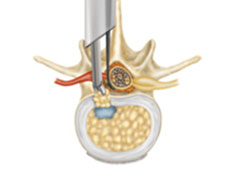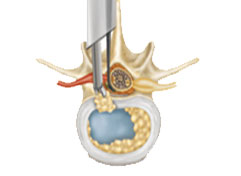Discectomy
Spinal surgery used to be associated with huge incisions, lengthy recovery periods, and unpleasant rehab. Fortunately, medical breakthroughs such as the microdiscectomy surgery have made the procedure more effective.
Microdiscectomy, also known as microdecompression or microdiskectomy, is a minimally invasive surgical treatment used to treat ruptured lumbar discs.
A surgeon will remove sections of the herniated disc during this operation to relieve pressure on the spinal nerve column.
Procedure
Discectomy is a common surgery done to remove the ruputure component of a slipped or ruptured disc. These discs which are essentially cushions between spinal bones have a softer inner portion which rupture through a hole which occurs in outer tough layer called annulus.
Two different surgical approaches exist:
- Aggressive
- Limited discectomy (or microdiscectomy).
Aggressive discectomy involves removing not only the herniated disc material but also most of the soft disc inside of the thick outer layer.
Microlumbar discectomy
Microlumbar discectomy (MLD) involves an inch of skin incision and very minimal root handling done under microscope and removal of only the herniated nuclear fragment. This surgery essentially tries to retain the normal disc contents which will contribute to function of the spinal segment.
This is the gold standard of care now a days.
Discectomy procedures are becoming more precise, pain free and are done even day- care with addition of more gadgets like endoscopic discectomy (6 mm incision which will not need a stitch) and tubular discectomy (16- 18 mm incision)

MLD – LIMITED FRAGMENTECTOMY /DISCECTOMY

AGGRESSIVE DISCECTOMY
Discectomy procedures are becoming more precise, pain free and are done even day- care with addition of more gadgets like endoscopic discectomy (6 mm incision which will not need a stitch) and tubular discectomy (16- 18 mm incision).
Complications:
• Nerve damage (<1 %)
• Bleeding
• Infection (<1%)
• Incision Pain
• Spinal fluid leak (<1%)
• Re-herniation (4- 7%)
Infection and re-herniation which are very rare may need another intervention depending on the clinical features at presentation.
RECOVERY
Most often discharge is done on the same day. People may resume activities from day 1. Return to job will be in 2-3 weeks depending on the disc status and the amount of tissue handling during surgery and the hole encountered in surgery.
